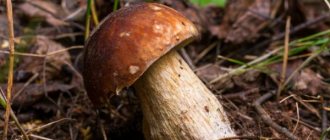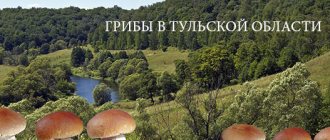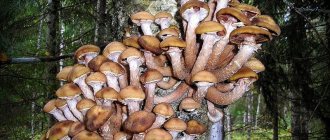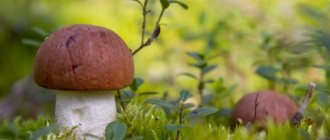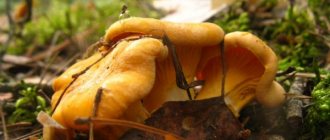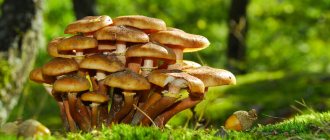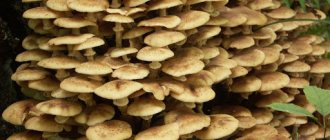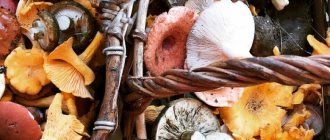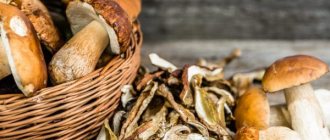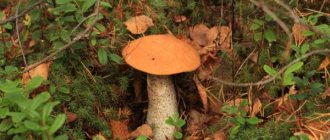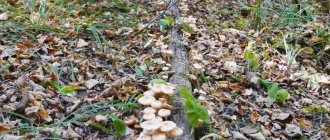Various edible mushrooms grow on the territory of the republic (porcini, boletus, aspen, etc.), but the most popular in Karelia are honey mushrooms. They are mainly found in coniferous forests. Most often they can be found between May and October. They look like small fluffy balls that have a cap that is white, orange, yellow and brown. They have no taste or smell; they very rarely cause poisoning because they ripen quickly.
At the same time, they have a peculiarity: they mostly grow in families, so once you find one, you can collect a whole basket. There are also oyster mushrooms in Karelia. They are edible, but not very tasty, but healthy. They can be used to make soup.
Expert opinion
Gennady Sergeevich Rylov
A great expert in mycology and an avid mushroom picker. Knows everything about mushrooms, their types and places of growth
If you pick mushrooms incorrectly, there is a chance of getting poisoned. Therefore, before you start collecting, you must definitely study the popular species.
Mushrooms of the region
In these places you can find a wide variety of mushrooms. For example, in the forests near Medvezhyegorsk a mushroom called “variegated umbrella” grows. He's very interesting.
And in Belomorsk they find a “swine” or a fat pig. This is a species that is often called “rotten Christmas tree”, or otherwise “deer beard”. It is also quite interesting; its shape can be compared to a spruce branch. “Gall mushroom” is also called yellow mushroom. It is difficult to confuse it with other species.
In the area of the village of Pyalma, local residents find boletus mushrooms. They grow in large groups. There are also other mushrooms. Honey mushrooms most often sprout in pine forests. But here they can be collected until late autumn.
There are many species on the White Sea coast: russula, boletus, boletus. In good weather, they can grow in whole families. Mushrooms are collected in large quantities.
Flag of the Republic of Karelia.
Vyborg
This is the end of the Priozersky region - the richest in mushrooms, but the journey on the map does not stop there. In the west is the city of Vyborg. The pure pine forests of the Leningrad region surrounding the city, mirror lakes, and mountains make this place a truly beautiful corner of nature. Transport connections here are much better developed, and therefore getting to mushroom places is not difficult. In dense forests, many boletus, aspen and porcini mushrooms are found. You need to be extremely careful when moving through the thickets, since the Finnish border passes through them, and it is advisable not to cross it. It doesn't hurt to take a map of the area, a compass or a navigator with you.
What is collected in spring, summer and autumn
In spring, species that are called “fruitful” grow in the republic. These are morels and lines. Mushroom pickers note that morels appear the earliest. After they appear, the lines come. Morels grow in different types of soil, in forests, and in forest clearings.
Strings grow only in rich, moist soils. Contains strong poison. It looks like meat. But the mushroom is not edible.
1-Giant morel 2-Common morel
are collected in August . When they grow, they turn red. They are difficult to confuse with other mushrooms. They are very similar to red tomatoes. But you can't eat them. These russulas have poisonous flesh. It turns blue when cut, becomes black, and then turns green.
1-Russula violet-green 2-Russula pungent
In summer, mushroom pickers of the republic collect honey mushrooms . They love moist soils. Most often they grow in birch, spruce, and oak forests. It is very tasty. Especially with potatoes.
_pariduccio_
thefriendlyfungus
are found in autumn . This is the most favorite species of many mushroom pickers. It can be fried, pickled, salted.
Porcini
Collecting money . The boletus with a red cap is one species, and the one with a white cap is another. They need to be distinguished.
whereyourbodysplit
the_mushroom_forager
forest_photos_
missmavis66
fly agaric
A more attractive mushroom than the red fly agaric can hardly be found. During ripening, white flakes form on the surface of the cap. It is the red hat with white polka dots that is the main attracting factor. This mushroom, with its attractive colors and shape, often causes fatal consequences for ignorant mushroom pickers, and especially children.
Its habitat is not limited to the territory of Russia; it grows with equal success in European, Asian countries and even in Australia.
It is important to know that this mushroom has different colors: from white, greenish, gray to bright red. After all, there are many types of mushrooms of the Amanita genus. And most of them are deadly.
The stinking fly agaric is the most poisonous of all its brothers. It doesn't look as nice and looks like a toadstool. It has a cone-shaped yellowish cap. When cut, it emits a foul odor. People often used it as a remedy for harmful insects. Traditional healers used medicines based on fly agaric in the treatment of nervous diseases.
Amanita stinking
Edible
Mushrooms of Karelia are famous for their amazing properties. With their help, many diseases can be cured. On a “silent hunt” in Karelia, the main thing is not to forget about personal safety.
Edible mushrooms of the republic:
- White, or boletus.
- Moss fly.
- Boletuses.
- Milk mushrooms.
- Honey mushrooms.
- Butter.
- The milk mushrooms are yellow.
- Green russula.
- Russula yellow.
- Russula red.
- Summer honey fungus.
- Autumn honey fungus.
- Winter honey fungus.
- Boletus mushrooms.
- Chanterelles.
- Lines.
- Russula.
- Summer honey fungus.
- The honey fungus is late.
- Autumn honey mushrooms.
- Spruce damp.
- Wet gray.
- Brownish wetness.
- Black wetness.
- Golden wet.
- Wet oak.
- The wetness is sticky.
- The wetness is turning pink.
- Wet fluff.
- Wet green.
- Wet yellow.
- Honey fungus
- Honey fungus is yellow.
In the forests located near the city of Petrozavodsk, you can find many mushrooms and choose the most interesting ones for yourself. You should not ignore species that grow in close proximity to roads or industrial areas.
These include champignons . They are the result of natural selection, so they grow very quickly and practically do not accumulate nitrates. In general, forest species are simply a paradise for mushroom pickers.
1-Forest champignon. 2-Möller's champignon.
boletus
In the Karelian forests there are two types of boletus: common and pinkish. In appearance, they differ from each other only in the color of the cap. You need to look for these mushrooms in dry birch groves or mixed forests. Although pink boletus can also be found in damper areas, in the highlands and tundra, not far from dwarf birches, this does not happen often.
Interesting fact: it is impossible to predict where these mushrooms will go next season in Karelia. Their yield is unpredictable. In the high year, boletus mushrooms literally fill the Karelian forests. But already in the next season they can suddenly disappear, and after a couple of years they can return in even greater numbers.
Poisonous mushrooms
- Death cap. Found everywhere. Differs from others in the pale color of the cap. It is convex, with a wavy edge, sticky in wet weather, shiny when dry, and in rare cases funnel-shaped. Diameter - 5 - 12 cm, fine-fibrous, smooth, moist. The color is white, yellowish, slightly olive-brown. The plates are narrow, frequent, white, slightly yellowing in old mushrooms. The leg is white, cylindrical, 10–20 cm long, 0.2 cm thick, dense, elastic, smooth. The pulp is white and does not change color in air.
White grebe. - Lobovik-yellow-red. Found in coniferous and mixed forests. The diameter of the cap is up to 20 cm. The skin is smooth, bare, shiny. The color is yellowish. There are tubercles on the stem and under the cap. Under the skin, the plates are whitish, then ocher, and brownish in the center.
- Gall mushroom. Rarely found, forms mycorrhiza with oak. The cap is up to 10 cm in diameter, at first convex with a bend towards the edge, then flat with a tubercle at the base. The skin is smooth. The plates are frequent. White color. The leg is up to 8 cm long, light, with white scales at the base. The pulp is thick, turns red when broken, then acquires a brown tint.
- Boletuses growing along the roads. The caps of young mushrooms are oval, bright orange, and over time they become flat and fleshy. The skins on the surface are sparse. Packed tightly on legs.
Waxy talker
Grows in open areas covered with grass: meadows, parks, squares, forest edges. It can be found throughout Russia and many European countries. The dimensions of the mushroom are small: the maximum diameter of the cap is 6 cm. While the mushroom is young, it is convex, in a mature state it is concave. The white under-hat plates immediately darken when pressed. The leg is high, straight, slightly tapering towards the bottom.
The danger of this mushroom lies in its external attractiveness. It is difficult to recognize a poisonous mushroom in it; it has a rather pleasant smell and is white in color. However, it is necessary to remember the main distinguishing feature: the under-hat plates are fused to the leg.
This mushroom contains the toxin muscarine, which can affect the digestive organs, heart, and glands.
Taking into account the fact that the waxy govorushka at a young age is practically no different from the edible mushroom of the family Ryadovka, it is better not to touch it.
Mushroom places of Karelia
The collection season begins for the residents of the republic when they go to the forest for several days, if not for a whole week. Gain strength after a cold winter, warm up from the piercing frosts. By picking mushrooms, Karelians find themselves in their magical places, where nature seems to freeze. In such forest thickets you can find almost any species.
But you don't see many of them often. According to the press service of the Ministry of Forestry, some varieties of edible mushrooms are not found in our forests, since they are simply not cultivated or grown on an industrial scale. These species include oyster mushrooms, ball mushrooms, pigweeds, rows, greenfinches, autumn honey fungus, and morels. For residents of Karelia and the city of Petrozavodsk who love picking mushrooms, there is an opportunity to visit their own special forest.
One of the richest places in the republic is the area near the village of Yb, which is located in the Syktyvdinsky district. Here local residents harvest large crops.
Mushrooms that are found in Karelia can be divided into 6 groups:
- Caps are those that we usually eat: boletus, boletus, russula, chanterelles, honey mushrooms, boletus.
- Honey mushrooms - they can be found mainly on stumps, in the rotten wood of old trees.
- Slime molds - they live in the roots, there are a lot of them, especially in coniferous forests. It is a ball filled with liquid, which can reach a diameter of up to 20 cm.
- Butterflies do not grow on the ground, but on stumps and trunks.
- Pigs - they can only be found in birch groves. The thick pig is a lithophyte mushroom.
- Rows - they grow in clearings, meadows, and forest edges.
Memo for mushroom picker
To avoid poisoning when collecting and storing mushrooms, you should follow the following safety rules:
- Do not collect mushrooms in bags or bags.
- Take only those species that you know for sure.
- Do not collect old and wormy mushrooms.
- If, after coming home, you find poisonous mushrooms among the edible mushrooms, you should throw away all the mushrooms.
- You cannot take mushrooms along roads or in cemeteries.
- It is advisable to cook the crops on the day of collection, as they quickly deteriorate.
- You cannot feed mushroom dishes to preschool children - their bodies do not have the enzymes necessary to digest this product.
- Harvesting rules should be carefully followed.
Today in Karelia, the forecast for the mushroom harvest for 2022 is very optimistic, despite the late start of the season. So don’t waste your time and go to the forest for a rich harvest! There are plenty of mushroom places in the vicinity of our park hotel.
And if you want to combine business with pleasure, then we can organize for you a real “mushroom safari” - a boat trip on Ladoga to the islands to pick mushrooms. Very few mushroom pickers get there, so the mushroom harvest there can be truly impressive.
What is collected in spring, summer and autumn
The spring season begins on the second day after the snow melts and lasts until mid-May. In April - oiler, moss mushroom, saffron milk cap. May is the time of chanterelles, nigella, and honey mushrooms.
June-July you can collect boletus, boletus, and boletus.
September is the time of boletus, boletus, boletus, white, and Polish. And, of course, the autumn mushroom is white. Autumn species are often collected after the rains, and boletus, boletus, chanterelles and honey mushrooms - only after they “sing”. This is what they call it when they begin to change color - these mushrooms develop a characteristic smell, which, by the way, some people feel disgusted by. But you need to be more careful with volnushki and morels in the fall. Chanterelles can be collected from the second half of October to mid-November.
Features of poisoning
When eating any poisonous mushrooms, a person experiences the following symptoms:
- Acute pain in the abdominal area (stomach and intestines).
- Nausea and vomiting.
- My head is spinning.
- Consciousness weakens or is lost.
When certain types of poisonous mushrooms enter the body, other symptoms may occur. For example, toadstool causes a condition that can be divided into 3 phases:
- Hidden lasts from 60 minutes to 1.5-2 days.
- Damage to the digestive system – from 1 to 2 days.
- Impaired kidney and liver function – the next day.
The first stage is dangerous due to the absence of symptoms. The second entails severe vomiting, headaches, diarrhea, abdominal pain, and severe weakness. During this period, it is necessary to take urgent measures that can guarantee the salvation of the patient. The last phase is the appearance of tar-like stool, the skin turns yellow, blood is found in the urine, and vomit looks like coffee grounds. At this stage, it is very difficult to save the patient’s life; most often, death is likely.
The satanic mushroom is one of the most insidious, because the human body does not give any signals of poisoning for 12 hours. During this time, deadly toxins manage to infect the internal organs of the victim. Only half a day later the first signs appear: vomiting, diarrhea, dizziness. These symptoms include yellowness of the skin, eyeballs, and irregular heartbeat. Urine the color of dark beer, a noticeable enlargement of the liver, clouding of consciousness - this is a critical condition when it is almost impossible to save a person from death.
The fly agaric causes severe cutting pain in the peritoneum, loose stools, heavy sweating, excessive salivation, lacrimation, and the pupils are constricted to the limit. The poisoned person experiences high fever, increased agitation, hallucinations, and slurred speech.
This video provides visual information about the main features, similarities and differences between poisonous mushrooms and edible ones:
